Sweet Potato and Kale Breakfast Hash
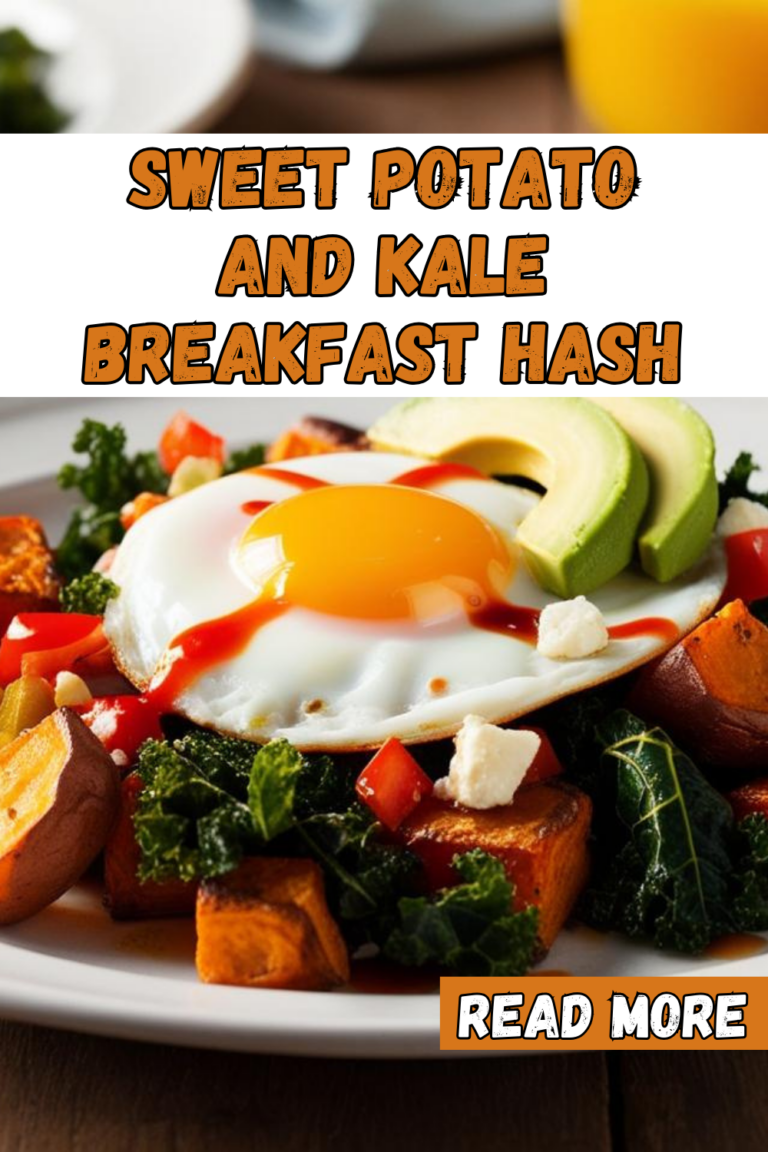
A Deliciously Healthy Start to Your Day
Looking for a breakfast that’s not only delicious but also packed with nutrients to fuel your day? This Sweet Potato and Kale Breakfast Hash is the perfect way to start your morning. With golden roasted sweet potatoes, tender kale, and a perfectly cooked sunny-side-up egg, every bite is a balance of flavor and texture. It’s the kind of dish that feels indulgent but is secretly loaded with wholesome ingredients. Whether you’re preparing a quick weekday breakfast or hosting a cozy weekend brunch, this hash will impress every time.
What makes this recipe even better is its versatility. You can easily customize it with your favorite toppings, like creamy avocado, tangy feta cheese, or a spicy drizzle of hot sauce. Plus, it’s simple to make and perfect for meal prepping ahead of a busy week. Healthy, hearty, and absolutely satisfying, this breakfast hash is bound to become a go-to in your kitchen!
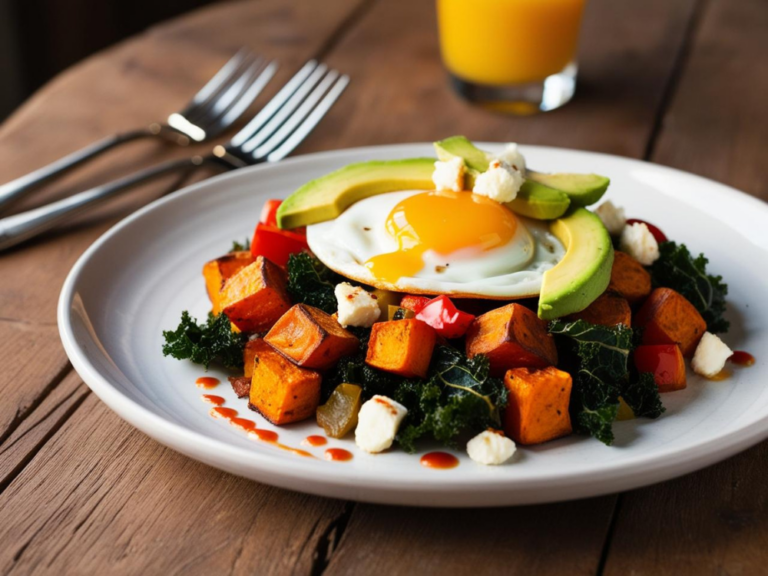
Health Benefits of Sweet Potatoes and Kale: Why This Breakfast Hash is a Superfood Powerhouse
When it comes to healthy eating, the combination of sweet potatoes and kale is a match made in heaven. Both of these ingredients are powerhouses of nutrition, offering a variety of health benefits that make them perfect for starting your day off right. By incorporating them into a delicious breakfast hash, you’re not only treating your taste buds, but you’re also giving your body a hearty dose of vitamins, minerals, and antioxidants that will keep you feeling energized and nourished throughout the day.
Sweet Potatoes: A Nutrient-Dense Root Vegetable
Sweet potatoes are one of the most nutrient-dense root vegetables you can include in your diet. They are rich in complex carbohydrates, fiber, and vitamins that offer an array of health benefits. For starters, sweet potatoes are a fantastic source of beta-carotene, an antioxidant that the body converts into vitamin A. Vitamin A plays a crucial role in maintaining healthy vision, supporting immune function, and promoting skin health. In fact, just one medium-sized sweet potato provides over 150% of your daily recommended intake of vitamin A!
But that’s not all—sweet potatoes are also packed with vitamin C, a powerful antioxidant that helps to fight inflammation and supports the body’s ability to absorb iron. The combination of vitamin A and vitamin C makes sweet potatoes excellent for maintaining a healthy immune system, especially during the colder months. Plus, their high fiber content (about 4 grams per medium potato) helps keep your digestive system running smoothly and supports heart health by lowering cholesterol levels.
Sweet potatoes are also a great source of potassium, an essential mineral that helps regulate blood pressure and fluid balance in the body. For those looking to reduce sodium intake, potassium-rich foods like sweet potatoes can help maintain a healthy balance and support optimal heart health. And let’s not forget their low glycemic index, which means they provide steady, sustained energy without causing blood sugar spikes, making them an excellent choice for those monitoring their blood sugar levels.
Kale: A Leafy Green Packed with Nutrients
Kale is another nutritional superstar that brings a wealth of health benefits to the table. This leafy green vegetable is loaded with vitamins A, C, and K, and is also a great source of calcium, iron, and magnesium. The health benefits of kale are truly impressive, especially when it comes to supporting your bones and overall immune system.
As with sweet potatoes, kale is an excellent source of vitamin A (in the form of beta-carotene), which supports healthy vision and boosts immune function. It also contains vitamin K, which plays a critical role in blood clotting and bone health. Kale’s high vitamin C content helps combat oxidative stress, supports collagen production for healthy skin, and strengthens your body’s defenses against illness. It’s no wonder kale is often referred to as a “superfood!”
Additionally, kale is packed with calcium and iron, two vital minerals that are essential for maintaining strong bones and healthy blood. Kale’s calcium content is particularly beneficial for those who may not consume dairy products, offering a plant-based alternative for bone health. Iron, on the other hand, helps with oxygen transport in the blood and can help prevent fatigue and weakness.
One of the standout benefits of kale is its antioxidant properties. Kale contains a range of antioxidants, including flavonoids and carotenoids, which help protect the body from harmful free radicals that can cause chronic diseases and accelerate aging. Its powerful anti-inflammatory effects also support joint health and reduce the risk of chronic conditions like heart disease and cancer.
Combining Sweet Potatoes and Kale: The Perfect Nutritional Duo
Together, sweet potatoes and kale make an unbeatable combination when it comes to nourishing your body. While sweet potatoes provide a healthy dose of complex carbs, fiber, and vitamins that boost energy and support digestion, kale adds a punch of essential vitamins, minerals, and antioxidants that help protect the body from illness and inflammation.
The combination of these two nutrient-dense ingredients in a Sweet Potato and Kale Breakfast Hash ensures that you’re starting your day with a balanced, satisfying meal that provides essential nutrients for both your body and mind. Whether you’re trying to improve your digestion, support your immune system, or simply enjoy a delicious breakfast, this powerful duo has got you covered.
By adding this breakfast hash to your weekly meal rotation, you’re not only enjoying a flavorful dish but also reaping the benefits of these amazing ingredients. So go ahead—take a bite and enjoy all the amazing health benefits sweet potatoes and kale have to offer. You deserve it!

How to Make This Recipe Vegan or Vegetarian: Easy Substitutes for Every Diet
Whether you’re following a plant-based diet, trying to cut back on animal products, or simply prefer to enjoy more vegetables, this Sweet Potato and Kale Breakfast Hash is incredibly versatile. With a few easy swaps, you can transform this hearty, comforting breakfast into a fully vegan or vegetarian-friendly meal without sacrificing flavor or nutrition. In fact, you’ll find that the dish becomes even more customizable, catering to a variety of dietary needs and preferences. Here’s how you can make this recipe work for you, no matter what diet you’re following.
Vegan Options for Sweet Potato and Kale Breakfast Hash
For those following a vegan lifestyle, the most obvious change you’ll want to make is in the egg department. While eggs are traditionally included in breakfast hash recipes, they can be easily replaced with plant-based alternatives that still provide a similar texture and flavor profile. Here are a few excellent options:
1. Scrambled Tofu or Chickpea Flour Scramble
To replicate the texture and protein content of eggs, you can use scrambled tofu or a chickpea flour scramble. Both options are high in protein and can easily be seasoned to match the savory, flavorful notes of scrambled eggs. Here’s how to use them:
- Scrambled Tofu: Simply crumble firm tofu into a skillet and sauté with a bit of olive oil, turmeric (for color), black salt (for an “eggy” flavor), and a pinch of garlic or onion powder. The result is a soft, scrambled filling that can be stirred directly into your hash.
- Chickpea Flour Scramble: Mix chickpea flour with water and seasoning to create a batter, then cook it in a pan like scrambled eggs. Chickpea flour is a great source of plant-based protein and provides a dense, satisfying texture.
Both of these options will give your breakfast hash the same comforting, rich flavor and texture as traditional scrambled eggs but without the use of animal products.
2. Vegan “Fried” Egg
For a more aesthetic approach, you can create a vegan fried egg using ingredients like aquafaba (the liquid from a can of chickpeas) or cashew cream. The mixture can be cooked in a non-stick pan, and once cooked, you can top your hash with it just like you would with a regular fried egg. For the yolk, many vegans use turmeric to give it a yellow color and a bit of texture that mimics a runny egg yolk.
3. Vegan Cheese
If you love the creamy texture of cheese on your breakfast hash, try using a dairy-free cheese like vegan feta, nutritional yeast (which has a cheesy, nutty flavor), or even vegan mozzarella. These cheese substitutes melt beautifully and add that same satisfying, savory richness to the dish.
4. Avocado
For extra creaminess, avocado slices work beautifully as a topping. Not only does it provide a creamy texture, but it also adds heart-healthy fats that will keep you feeling full longer. Plus, the fresh, green color of avocado complements the rich, earthy flavors of sweet potatoes and kale perfectly.
Vegetarian Options for Sweet Potato and Kale Breakfast Hash
If you follow a vegetarian diet, the recipe is already largely suitable, as it’s easy to make it vegetarian-friendly by simply keeping the egg as-is. However, you might want to add a few tweaks or substitutions to boost protein or to elevate the flavors.
1. Cheese Options
For those who eat dairy, adding a few tablespoons of crumbled goat cheese or feta cheese can elevate the flavor of this hash. The tanginess of feta pairs wonderfully with the sweetness of the roasted sweet potatoes, adding a layer of depth. If you’re not a fan of feta, you could also use cheddar or parmesan, which both bring a sharp, savory element to the dish.
2. Add More Protein with Beans
To make the dish even more filling, consider adding some beans, such as black beans or chickpeas, to the hash. These not only add extra fiber and protein but also work well with the earthy kale and sweet potatoes. Simply heat them through and toss them into the hash along with the other vegetables.
3. Cooked Eggs
If you’re sticking with the vegetarian version and don’t mind using eggs, try experimenting with different types of eggs to suit your preference:
- Poached Eggs: Poaching eggs adds a silky texture with a slightly runny yolk that blends beautifully into the hash.
- Baked Eggs: Crack eggs into the skillet or a baking dish with the hash mixture, and bake in the oven for a more hands-off approach. This method creates a uniform consistency and ensures the eggs cook evenly with the rest of the dish.
- Soft-Boiled Eggs: For a touch of elegance, soft-boiled eggs with a runny yolk make an excellent topping for this dish.
4. Sauteed Mushrooms
If you’re looking for additional umami flavor and a meaty texture, try adding sautéed mushrooms to the hash. Mushrooms like cremini or shiitake offer a savory, slightly earthy taste that complements the sweet potatoes and kale. They’re a great alternative for vegetarians seeking a richer flavor without meat.
Additional Tips for Customizing Your Breakfast Hash for Vegan or Vegetarian Diets
- Vegetable Variations: Kale isn’t the only leafy green that works well in this hash. You can easily swap kale for spinach, Swiss chard, or even arugula for different textures and flavors. If you prefer more variety in the veggies, try adding red onion, zucchini, or mushrooms for a heartier hash.
- Add More Crunch: For some extra texture, consider adding a handful of seeds (like pumpkin or sunflower seeds) or toasted nuts (like almonds or walnuts) for a delightful crunch.
- Spices and Herbs: Experiment with different spice blends to enhance the flavors. Smoked paprika, cumin, or even a pinch of chili flakes can add warmth and depth to the dish, while fresh herbs like parsley or basil can provide a fresh, aromatic touch.
Conclusion: A Breakfast for Everyone
Whether you’re vegan, vegetarian, or simply looking to make a few swaps to suit your preferences, this Sweet Potato and Kale Breakfast Hash is incredibly adaptable. By making a few simple substitutions, you can create a breakfast that aligns with your dietary needs without compromising on flavor or nutrition. These easy changes ensure that this meal is a go-to option for everyone, no matter how you eat. So don’t be afraid to get creative and make this recipe your own—whether you’re cooking for yourself, your family, or a group of friends!
Try some of our other recipes!

Grilled Salmon with Garlic Spinach
Read More

Ginger Lemon Detox Tea
Read More
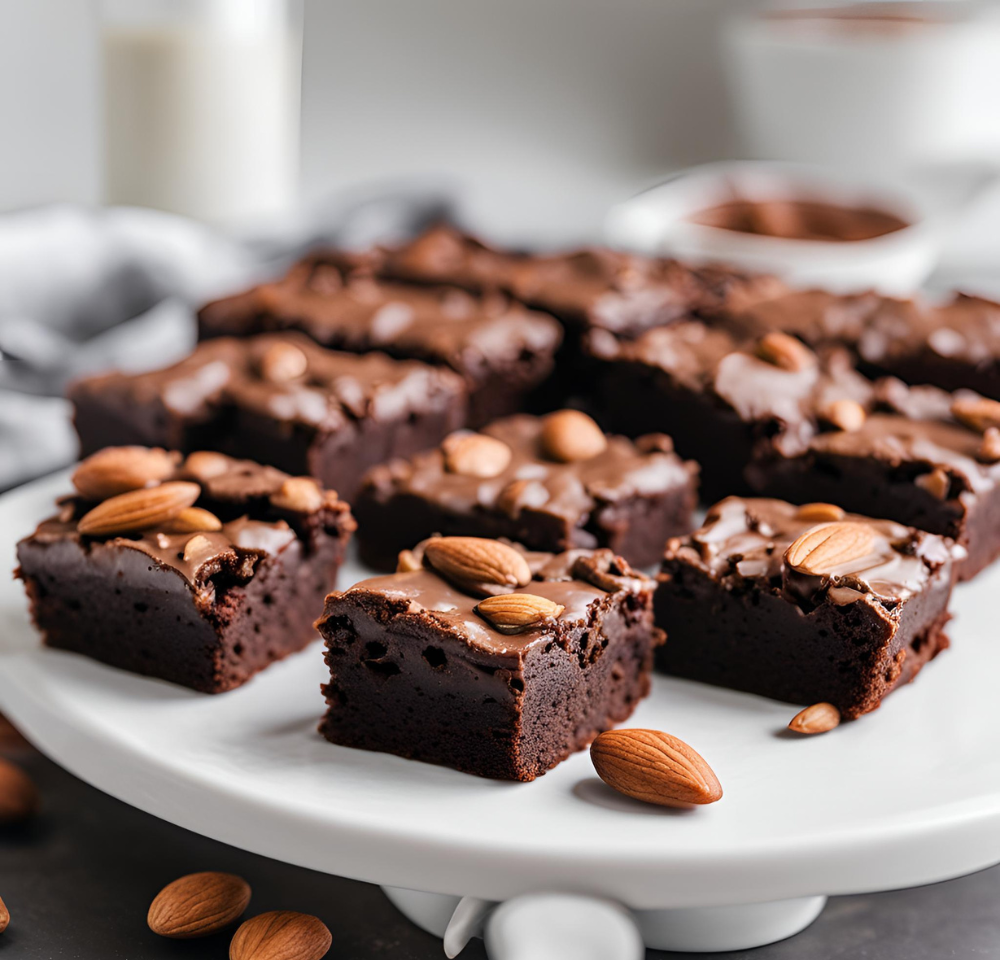
Gluten-Free Almond Flour Brownies
Read More
Nutritional Breakdown: Why Sweet Potato and Kale Breakfast Hash is a Healthy Choice
If you’re looking for a breakfast that not only tastes great but also fuels your body with the nutrients it needs to start the day, look no further than this Sweet Potato and Kale Breakfast Hash. Packed with wholesome ingredients, this dish offers a balanced combination of carbohydrates, protein, healthy fats, and vitamins, making it a perfect choice for a nutritious breakfast that keeps you feeling full and energized.
Sweet Potatoes: A Nutrient-Dense Source of Complex Carbohydrates
At the heart of this breakfast hash is the humble sweet potato, a nutritional powerhouse. Sweet potatoes are often praised for their complex carbohydrates—the kind that provide long-lasting energy without spiking your blood sugar. This makes them a great choice for anyone looking to maintain stable energy levels throughout the morning.
High in Fiber
Sweet potatoes are an excellent source of dietary fiber, with one medium sweet potato providing around 4 grams of fiber. Fiber plays a crucial role in digestive health by promoting regular bowel movements and supporting a healthy gut microbiome. It also helps manage blood sugar levels, making it an ideal food for those with diabetes or anyone looking to stabilize their energy levels throughout the day. The fiber in sweet potatoes also contributes to feelings of fullness, helping to curb unnecessary snacking.
Rich in Vitamins A and C
Sweet potatoes are loaded with beta-carotene, which the body converts into vitamin A. Vitamin A is essential for maintaining healthy vision, promoting immune function, and supporting skin health. Just one medium sweet potato provides more than 150% of your daily recommended intake of vitamin A, making it one of the best sources of this vital nutrient.
Additionally, sweet potatoes are packed with vitamin C, an antioxidant that helps protect the body from oxidative stress. Vitamin C is also important for collagen synthesis, which keeps your skin, joints, and tissues strong. It also boosts your immune system, helping to protect against common illnesses like colds and the flu.
Minerals and Antioxidants
Sweet potatoes are rich in potassium, a mineral that helps regulate blood pressure and balance fluids in the body. Consuming enough potassium can help reduce the negative effects of sodium, which can lead to high blood pressure. Potassium also supports muscle function, so it’s essential for staying active and feeling strong throughout the day.
In addition to potassium, sweet potatoes contain antioxidants that help fight inflammation and protect your cells from damage caused by free radicals. The antioxidants in sweet potatoes contribute to overall health and may reduce the risk of chronic conditions like heart disease and cancer.
Kale: A Superfood Leafy Green
The other key ingredient in this breakfast hash is kale, often referred to as a “superfood” due to its impressive nutrient profile. Kale is a nutrient-dense leafy green that brings an array of essential vitamins, minerals, and antioxidants to the table.
High in Vitamin K
Kale is an excellent source of vitamin K, a fat-soluble vitamin that plays a crucial role in blood clotting and bone health. Just one cup of chopped kale provides more than 600% of your daily recommended intake of vitamin K. This vitamin is essential for maintaining strong bones, as it helps with the regulation of calcium in the body. By including kale in your breakfast, you’re not only boosting your blood health but also giving your bones the support they need.
Packed with Vitamin C
Like sweet potatoes, kale is also loaded with vitamin C, making it an excellent addition to your diet for immune support. This water-soluble vitamin is crucial for the production of collagen, which keeps your skin, cartilage, and blood vessels healthy. Kale’s high vitamin C content contributes to the body’s ability to repair tissues and fight off infections. Including kale in your breakfast is an easy way to give your immune system a boost first thing in the morning.
Calcium and Iron
Kale is a great source of calcium, a mineral that is essential for bone health, muscle function, and nerve transmission. While dairy products are typically considered the best source of calcium, kale provides a plant-based alternative for those who follow a vegan or vegetarian diet. Just one cup of kale contains about 10% of your daily calcium needs, making it a great addition to any diet.
Kale is also a good source of iron, a mineral that plays a crucial role in oxygen transport throughout the body. Iron helps prevent fatigue and supports overall energy levels. If you follow a plant-based diet, getting enough iron from sources like kale is essential for maintaining healthy red blood cells and avoiding iron-deficiency anemia.
Antioxidants and Anti-Inflammatory Properties
Kale is rich in a variety of antioxidants, including flavonoids and carotenoids, which help protect the body from oxidative stress and inflammation. These antioxidants help fight free radicals, which can damage cells and contribute to aging and chronic diseases. The anti-inflammatory compounds found in kale also help reduce the risk of conditions like heart disease and arthritis.
The Perfect Nutritional Balance: Carbs, Protein, and Healthy Fats
What makes the Sweet Potato and Kale Breakfast Hash so well-balanced is its combination of complex carbohydrates from the sweet potatoes, plant-based protein from the kale and any added beans, and healthy fats from toppings like avocado or olive oil. This balance of macronutrients helps keep you feeling full and satisfied without any crashes or hunger pangs.
- Carbohydrates from sweet potatoes provide sustained energy without spiking blood sugar.
- Protein from kale, tofu (if added), and other plant-based sources helps repair tissues, build muscles, and keep you feeling fuller for longer.
- Healthy fats from avocado or olive oil support brain health, hormone regulation, and provide lasting energy.
Conclusion: A Nutritional Powerhouse in Every Bite
By combining the nutrient-rich sweet potatoes and kale, this breakfast hash is a powerhouse of vitamins, minerals, and antioxidants that promote overall health. It’s a meal that not only fills you up but also provides your body with the essential nutrients it needs to thrive throughout the day. Whether you’re looking to support your immune system, maintain strong bones, or simply start your day with a healthy, satisfying meal, this Sweet Potato and Kale Breakfast Hash is a great way to nourish your body from the inside out. Enjoy it regularly for a delicious and nutritious start to your mornings!
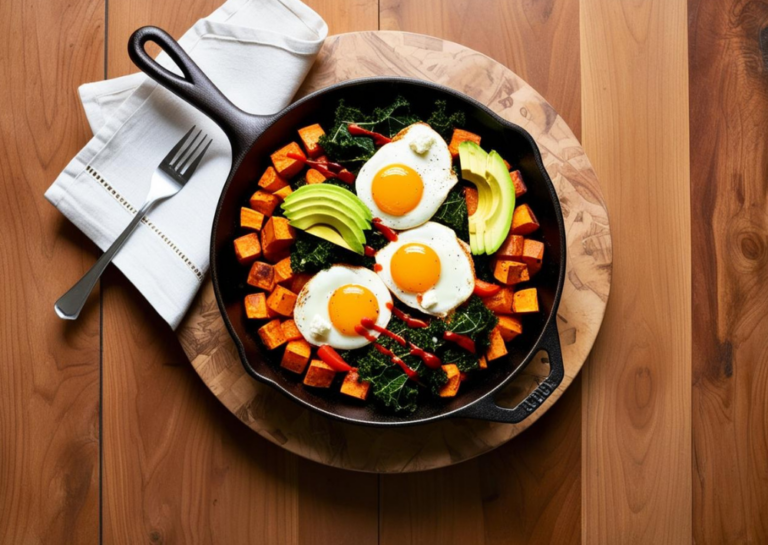
Pairing Suggestions: What to Serve with Sweet Potato and Kale Breakfast Hash
While the Sweet Potato and Kale Breakfast Hash is already a flavorful and satisfying dish on its own, pairing it with complementary sides and beverages can elevate your breakfast or brunch experience even more. Whether you want to add a refreshing drink, a sweet touch, or a savory side, the right pairings can enhance the flavors of your hash and provide a more well-rounded meal. Here are some fantastic pairing ideas to consider, so you can enjoy a perfectly balanced and delicious breakfast every time.
1. Fresh Juices: The Perfect Drink for a Nutritious Boost
A fresh glass of juice is a classic breakfast pairing that not only adds a burst of flavor but also provides extra vitamins to complement the nutrient-dense hash. Here are a few juice options that pair wonderfully with the Sweet Potato and Kale Breakfast Hash:
Orange Juice
A chilled glass of freshly squeezed orange juice is a timeless breakfast drink. The bright, tangy flavor of oranges balances the earthy, savory tones of the sweet potatoes and kale. Orange juice is rich in vitamin C, which boosts the immune system and supports collagen production for healthy skin. It’s a refreshing, hydrating choice that complements the hash’s richness perfectly.
Green Juice
If you’re looking to keep your meal extra healthy, consider pairing your breakfast hash with a glass of green juice made from fresh spinach, kale, cucumber, and apple. Green juice is packed with essential vitamins and antioxidants, and it’s an excellent way to boost your vegetable intake while staying hydrated. The crisp, refreshing taste of green juice contrasts nicely with the hearty flavors of the hash, making it a perfect match.
Carrot and Ginger Juice
For a bit of spice and sweetness, try pairing your hash with carrot and ginger juice. The sweetness of the carrots blends beautifully with the warm, zesty kick of ginger. This juice is full of beta-carotene, which supports eye health and immune function, and the ginger provides digestive benefits, making it an energizing and nourishing drink to start the day.
2. Coffee: A Warm and Comforting Beverage
No breakfast feels quite complete without a hot cup of coffee. Whether you like it black, with cream, or as a latte, coffee pairs exceptionally well with the Sweet Potato and Kale Breakfast Hash. The bold flavor of coffee complements the savory sweetness of the hash and gives you a caffeine boost to jump-start your day.
Black Coffee
If you prefer a more straightforward, no-frills drink, black coffee is an ideal companion to your breakfast hash. The bitterness of black coffee balances the richness of the sweet potatoes and eggs, and it enhances the earthy flavor of the kale. Plus, the warm, comforting nature of coffee makes it a perfect pairing for a cozy morning meal.
Latte or Cappuccino
For a creamy, indulgent option, consider a latte or cappuccino. The frothy milk adds a smooth, creamy element that complements the texture of the sweet potatoes and the richness of the egg. A latte’s slight sweetness enhances the overall experience, creating a comforting breakfast that feels indulgent yet wholesome.
Iced Coffee
If you’re looking for a refreshing, chilled beverage, iced coffee is another great option. It’s especially perfect for warm mornings when you still want to enjoy the deep flavors of coffee but without the heat. Add a splash of almond milk or coconut milk for a dairy-free option that pairs seamlessly with the hash.
3. Fresh Fruit: Adding Sweetness and Balance
To bring a light, sweet contrast to the savory, hearty flavors of the hash, consider pairing it with some fresh fruit. The natural sweetness and juiciness of fruit create a beautiful balance with the richness of the sweet potatoes and eggs. Here are a few fruit options that work beautifully alongside this dish:
Avocado
While technically a fruit, avocado is often used as a savory addition to meals, and it’s an excellent choice for pairing with the hash. The creamy texture of avocado enhances the dish’s richness, and its subtle, nutty flavor complements the sweetness of the roasted sweet potatoes. Plus, avocado is packed with healthy fats and adds a refreshing creaminess to each bite.
Citrus Slices
For a tangy and refreshing contrast, try pairing the hash with citrus slices, such as grapefruit, oranges, or kiwi. The sharp, juicy flavor of citrus fruits helps to cleanse the palate between bites of the savory hash and adds an extra burst of vitamin C to your meal. The bright, zesty notes of citrus offer a refreshing lift that balances out the richness of the dish.
Berries
Fresh berries, such as strawberries, blueberries, or raspberries, are a fantastic option to add natural sweetness and antioxidants to your meal. The light, refreshing taste of berries complements the hearty nature of the hash and provides a touch of sweetness without overpowering the dish. You can also mix berries into a yogurt parfait or serve them on the side to add variety.
4. Whole-Grain Toast or English Muffins: A Savory Side
If you want to add a bit more substance to your meal, whole-grain toast or a whole-wheat English muffin makes an excellent side to the Sweet Potato and Kale Breakfast Hash. Toasted bread is a great way to add a satisfying crunch and some extra fiber to your meal.
Whole-Grain Toast
Opt for a whole-grain bread for a fiber-packed, nutrient-dense side. You can spread a thin layer of almond butter, peanut butter, or hummus on your toast for an extra dose of healthy fats and protein. The hearty crunch of the toast contrasts nicely with the tender sweet potatoes and wilted kale.
English Muffins
For a more classic, comforting side, serve the hash with a warm, toasted English muffin. If you’re feeling indulgent, you can spread a bit of butter or olive oil on top, or for a healthier twist, top it with avocado or a light drizzle of honey. The English muffin provides a soft, chewy texture that pairs well with the crispy, roasted sweet potatoes.
5. A Light Salad: Adding Freshness
For those who enjoy a lighter, fresh touch with their meals, a simple green salad is a perfect way to balance out the richness of the hash. A salad can help brighten the meal, adding an extra layer of flavor and texture. Here are some ideas for a simple, refreshing salad to pair with your breakfast hash:
Mixed Greens Salad
A light mixed greens salad with arugula, spinach, and baby kale pairs beautifully with the Sweet Potato and Kale Breakfast Hash. Top it with a tangy vinaigrette made from olive oil, lemon juice, and mustard to add a sharp contrast to the richness of the hash.
Cucumber and Tomato Salad
A refreshing cucumber and tomato salad with a simple olive oil and balsamic vinegar dressing offers a cool, crisp bite alongside the warm, hearty hash. The freshness of the cucumber and the juiciness of the tomatoes add lightness and brightness to the meal.
Conclusion: Elevate Your Meal with Perfect Pairings
While the Sweet Potato and Kale Breakfast Hash is already a delicious and satisfying dish on its own, pairing it with complementary sides and beverages can take your breakfast experience to the next level. Whether you’re sipping a refreshing juice, enjoying a warm cup of coffee, or adding a side of toast, these pairings help enhance the flavors of the dish and provide a more well-rounded, enjoyable meal. Experiment with these ideas and find the perfect combination that works best for your tastes, and you’ll be sure to enjoy a wholesome, balanced breakfast every time.
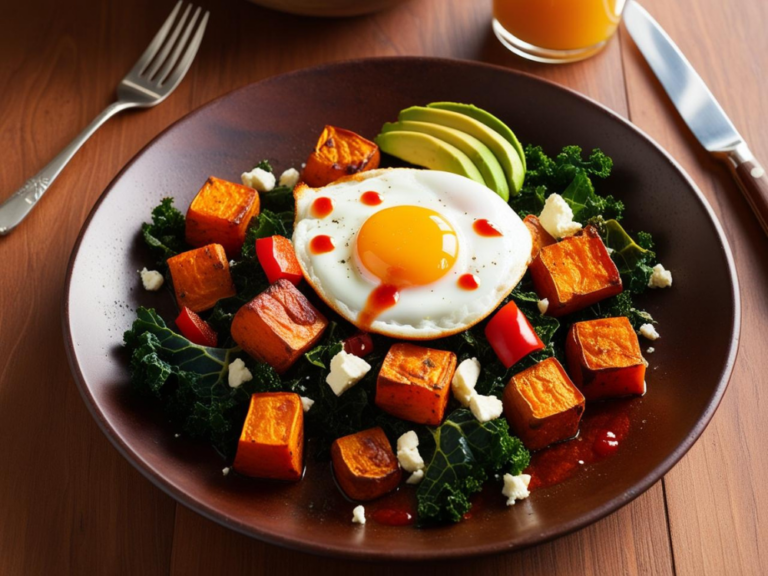
How to Adjust the Sweet Potato and Kale Breakfast Hash for Special Diets
One of the best things about the Sweet Potato and Kale Breakfast Hash is how incredibly versatile it is. Whether you’re following a specific diet for health reasons, ethical beliefs, or simply personal preference, this dish can easily be adjusted to suit a variety of dietary needs. With a few simple swaps or additions, you can modify this recipe to fit everything from gluten-free to vegan, low-carb, or Paleo diets, without sacrificing any of the delicious flavors or the satisfying texture of the dish. Here’s how you can make this breakfast hash work for different dietary requirements.
1. Making the Recipe Gluten-Free
For those who follow a gluten-free diet due to celiac disease, gluten sensitivity, or preference, rest assured—this Sweet Potato and Kale Breakfast Hash is naturally gluten-free. However, you’ll want to make sure that all the ingredients you use are certified gluten-free, especially any packaged items.
Ensure Gluten-Free Ingredients
- Seasonings and Spices: Most of the seasonings in this recipe (like paprika, garlic powder, onion powder, salt, and pepper) are gluten-free, but always double-check the labels. Some processed spices may have additives containing gluten.
- Cheese Alternatives: If you choose to add cheese, such as feta or goat cheese, check that it’s certified gluten-free. Some cheeses may contain trace amounts of gluten if they are processed in facilities that handle gluten products.
2. Adjusting for a Vegan Diet
If you follow a vegan lifestyle, there are a few straightforward swaps to make this breakfast hash entirely plant-based. The main non-vegan ingredients in the original recipe are the eggs and cheese. Fortunately, there are many delicious and satisfying vegan alternatives to keep the dish just as flavorful.
Replacing Eggs
Instead of using eggs, here are a few vegan alternatives that will add the richness and texture you crave:
- Tofu Scramble: Crumble firm tofu and sauté it with a little turmeric, nutritional yeast, and garlic powder to create a scrambled egg substitute. Tofu has a similar texture to scrambled eggs and absorbs spices well, making it a perfect replacement.
- Chickpea Flour Scramble: Mix chickpea flour with water and season it to taste. Once it thickens in the pan, it will resemble scrambled eggs and provide a protein boost similar to the real deal.
- Vegan “Fried” Egg: For a more realistic look and texture, you can make a vegan fried egg using a combination of aquafaba (chickpea brine) or cashew cream for the egg whites. Add turmeric for color and a pinch of salt for flavor. While it’s not quite the same as a traditional fried egg, it will provide a runny yolk-like texture when placed over the hash.
Replacing Cheese
If you love the creaminess and tang that cheese provides, consider using:
- Vegan Cheese: There are several great options on the market like vegan feta, cashew-based cheese, or soy-based mozzarella. These cheeses melt well and add a satisfying creamy texture.
- Nutritional Yeast: For a cheesy flavor without any dairy, sprinkle some nutritional yeast on top. It’s rich in B vitamins and adds a subtle, nutty flavor similar to cheese.
- Avocado: Instead of cheese, you could also top your hash with sliced avocado for a creamy, buttery texture that enhances the dish and adds healthy fats.
3. Low-Carb Adjustments
For anyone following a low-carb or keto diet, the sweet potatoes in this recipe can be swapped with lower-carb vegetables while still maintaining the satisfying texture and flavor.
Swap Sweet Potatoes for Low-Carb Vegetables
- Cauliflower: One of the best substitutes for sweet potatoes in a low-carb diet is cauliflower. You can cut cauliflower into small florets and roast or sauté it just like you would with sweet potatoes. It’s light, versatile, and absorbs the flavors of the seasonings beautifully.
- Zucchini: Another great low-carb alternative is zucchini. Dice it into small pieces and sauté it until tender. Zucchini has a mild flavor and can mimic the texture of sweet potatoes, though it will not have the same sweetness.
- Butternut Squash: If you’re looking for a bit of sweetness but still want to keep the carbs lower, butternut squash can be a great option. It has fewer carbs than sweet potatoes and adds a lovely richness to the dish.
Skip the Carbs in the Toppings
If you’re on a low-carb diet, avoid adding sweetened sauces or excess carbs like bread on the side. Stick to avocado, cheese, or tofu as toppings, which fit well within a low-carb or keto plan.
4. Making it Paleo-Friendly
The Paleo diet focuses on whole foods that our ancestors would have eaten, such as lean meats, fish, fruits, vegetables, and nuts. While this dish is already quite close to being Paleo-friendly, a few adjustments are necessary to fully align it with Paleo principles.
Replace Non-Paleo Ingredients
- Cheese: Most cheeses are not considered Paleo-friendly because they are dairy products. You can easily omit cheese from this recipe or use a dairy-free alternative made from coconut milk or cashews.
- Seasonings: Ensure the spices you use are whole and free from additives, preservatives, or anti-caking agents, as many commercially processed spice blends may contain non-Paleo ingredients. Stick to simple herbs and spices like garlic, onion, paprika, and fresh herbs.
Add More Protein
For a more protein-packed Paleo meal, consider adding some grass-fed beef, chicken sausage, or bacon. These protein sources align with Paleo guidelines and can make the meal even heartier.
5. Diabetic-Friendly Adjustments
For those with diabetes or anyone looking to manage their blood sugar levels, the Sweet Potato and Kale Breakfast Hash is already a solid choice due to the low glycemic index of sweet potatoes. However, for further blood sugar management, you can make a few adjustments to this dish to make it even more diabetic-friendly.
Opt for Non-Starchy Vegetables
To reduce the carbohydrate load, replace the sweet potatoes with cauliflower or broccoli. These non-starchy vegetables are high in fiber and have a minimal impact on blood sugar. You can also add spinach or Swiss chard for extra greens.
Increase Protein and Healthy Fats
Protein and healthy fats can help stabilize blood sugar levels. You can add extra protein by including lean meats (such as turkey or chicken) or plant-based options like tofu or tempeh. Healthy fats from avocado, olive oil, or a small handful of nuts will also help keep you fuller for longer and prevent blood sugar spikes.
Watch the Toppings
While toppings like avocado and cheese are generally fine, sour cream or sweetened sauces should be avoided. Stick to healthy fats and protein-rich options to maintain balanced blood sugar levels.
6. Adjustments for a Dairy-Free Diet
If you’re following a dairy-free diet, there are simple swaps to make this recipe safe and delicious:
- Cheese Alternatives: Use plant-based cheese made from almond, cashews, or coconut milk. Many brands offer great-tasting dairy-free cheese that will melt and add creaminess to your hash.
- Butter Substitutes: Instead of butter, opt for olive oil or coconut oil to sauté the vegetables. These oils are naturally dairy-free and provide healthy fats.
Conclusion: A Breakfast Hash for Everyone
No matter what dietary restrictions or preferences you follow, the Sweet Potato and Kale Breakfast Hash can be customized to meet your needs. From vegan swaps to low-carb adjustments, this recipe can be tailored to suit virtually any diet while still delivering the delicious flavors and satisfying textures that make it such a great choice for breakfast. By making a few simple swaps, you can enjoy this dish and nourish your body in a way that aligns with your lifestyle, health goals, or ethical beliefs.
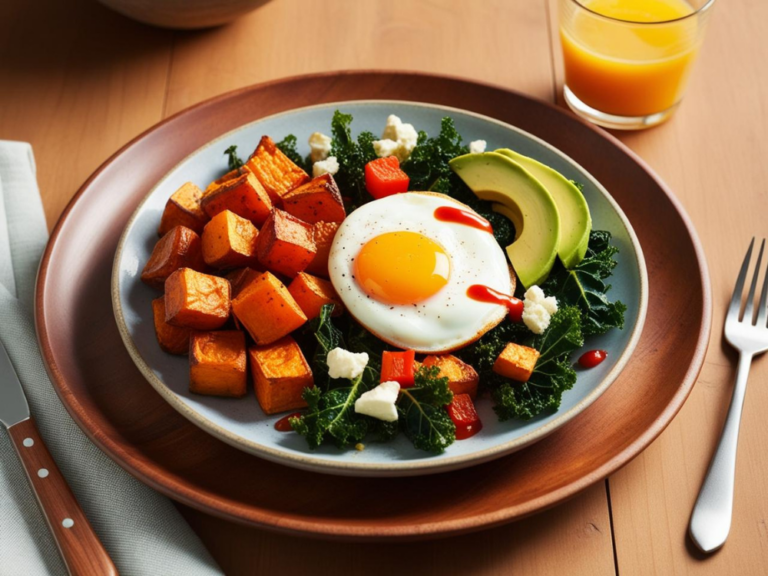
A Brief History of Sweet Potatoes and Kale: From Ancient Origins to Modern-Day Superfoods
Sweet potatoes and kale are two ingredients that have become staples in kitchens around the world, celebrated for their nutritional value and versatility. These superfoods are now found in everything from healthy breakfast bowls to hearty dinners, but their histories date back thousands of years. Understanding the origins of sweet potatoes and kale not only gives us a deeper appreciation for these foods but also highlights their enduring popularity and cultural significance. Here’s a closer look at the fascinating history of these two beloved ingredients.
The History of Sweet Potatoes: A Staple Root with Ancient Roots
Sweet potatoes have been cultivated for thousands of years, making them one of the oldest known crops in human history. The origins of the sweet potato can be traced back to Central and South America, where it was first domesticated by indigenous peoples over 5,000 years ago. Archaeological evidence suggests that the sweet potato was cultivated in the region as far back as 2,000 BCE, and it quickly became a staple in the diets of ancient civilizations.
From the Americas to the Rest of the World
The sweet potato’s journey to other parts of the world began with the Columbian Exchange in the late 15th and early 16th centuries. After Christopher Columbus and other European explorers arrived in the Americas, they encountered the sweet potato and brought it back to Europe. From there, it spread to other parts of the world, including Africa and Asia, where it adapted to different climates and became an integral part of local cuisines.
Sweet potatoes were quickly embraced in Europe, where they were initially grown in the Mediterranean region. In Africa, they became particularly important because of their ability to thrive in various climates, including those with dry conditions where other crops might struggle. The crop was introduced to Asia in the 17th century, where it became especially popular in countries like Japan, China, and India, where it is still widely cultivated today.
Sweet Potatoes and Their Nutritional Importance
In addition to their wide geographical spread, sweet potatoes have long been valued for their nutritional benefits. Rich in complex carbohydrates, fiber, vitamins A and C, and potassium, sweet potatoes have been a source of nourishment and energy for centuries. In fact, they were often considered a “famine food” in many parts of the world, providing sustenance in times of scarcity due to their ability to grow in diverse conditions.
Throughout history, sweet potatoes have been used for much more than just food. They were often employed for medicinal purposes, particularly in indigenous cultures. The leaves of the sweet potato plant, for example, were sometimes used to treat wounds and promote healing, and the root itself was believed to help with digestion and various ailments.
The History of Kale: The Ancient Green That Hasstood the Test of Time
Kale, on the other hand, has a history that stretches back to ancient Europe, where it was cultivated long before the advent of modern agriculture. Like sweet potatoes, kale was an essential food crop in ancient times, valued for its hardiness and nutritional content. Kale was first domesticated by the ancient Greeks and Romans, who recognized its ability to grow in a variety of climates and conditions.
Kale in Ancient Civilizations
In ancient Greece, kale was a commonly grown vegetable, especially in the Mediterranean regions, where it was used both as a food and for medicinal purposes. The Greeks and Romans were known for their interest in healthy living and nutrition, and kale was often recommended for its health benefits. It was believed to aid in digestion and even prevent illness. In fact, the Greek physician Hippocrates, often referred to as the “Father of Medicine,” recommended kale for its medicinal properties.
By the Middle Ages, kale was widely cultivated throughout Europe, particularly in the colder climates where other crops would not thrive. Kale’s ability to survive through harsh winters made it an invaluable crop, especially in northern Europe, where it was grown as a hearty winter vegetable. During these periods, kale was used in a variety of dishes, often cooked with meats or grains to make filling and nutritious meals.
Kale’s Role in the Renaissance and Beyond
By the Renaissance period, kale had spread across Europe and was widely consumed by the European working class. It became an essential part of the diet, often appearing in soups, stews, and other simple dishes that provided much-needed nutrition. Kale’s popularity continued into the 17th and 18th centuries, where it remained a dietary staple, particularly in the UK and Northern Europe.
During the 19th and early 20th centuries, kale began to lose some of its widespread popularity as new, more exotic vegetables came into fashion. However, it maintained its status as a hardy, reliable crop in areas where other vegetables might fail. It wasn’t until the late 20th and early 21st centuries that kale experienced a resurgence in popularity, especially with the rise of the health food movement. Today, kale is celebrated as one of the healthiest vegetables available, often touted for its high levels of vitamins K, A, and C, calcium, and antioxidants.
Sweet Potatoes and Kale: Superfoods of the Modern Era
Today, sweet potatoes and kale are often hailed as superfoods, thanks to their impressive nutrient profiles and the health benefits they offer. The rise of social media and the popularity of food blogs and cooking shows has helped fuel their resurgence in modern cuisine. Sweet potatoes, with their natural sweetness and versatility, are used in everything from savory dishes like hash to baked goods, smoothies, and even desserts. Meanwhile, kale, with its robust flavor and hearty texture, is often found in salads, smoothies, soups, and stir-fries, and has become a symbol of healthy eating.
In recent years, these two vegetables have become beloved ingredients in health-conscious recipes. As more people embrace plant-based, low-carb, and gluten-free diets, sweet potatoes and kale are often found at the heart of such meals due to their versatility and ability to provide essential nutrients.
Conclusion: A Legacy of Flavor and Nutrition
The histories of sweet potatoes and kale are as rich and diverse as the cultures that have embraced them over the centuries. From their humble beginnings in ancient civilizations to their status as modern-day superfoods, these two ingredients have withstood the test of time, proving to be as nutritious and versatile as ever. Whether enjoyed together in a breakfast hash or as part of a larger meal, sweet potatoes and kale continue to nourish and delight people all over the world. Their long history not only speaks to their culinary importance but also to their enduring value in human nutrition and health. So, the next time you enjoy a meal featuring these powerful ingredients, remember their rich cultural legacy and the countless generations that have enjoyed their benefits.
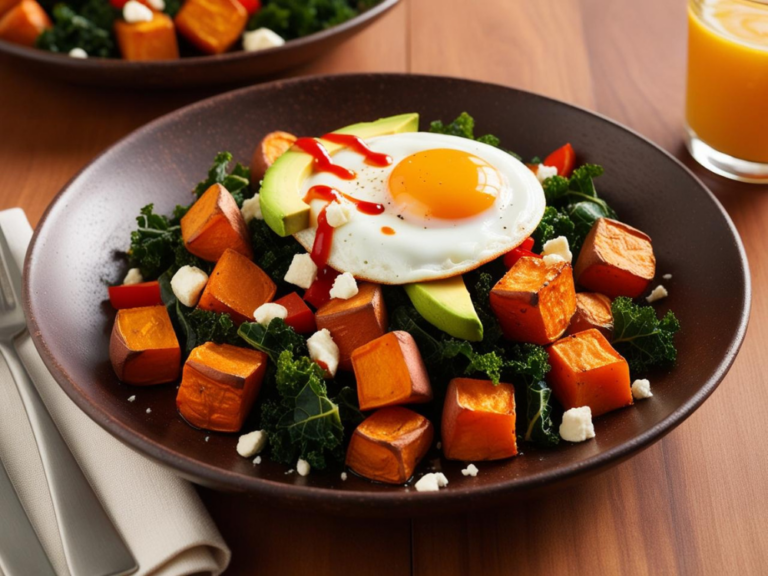
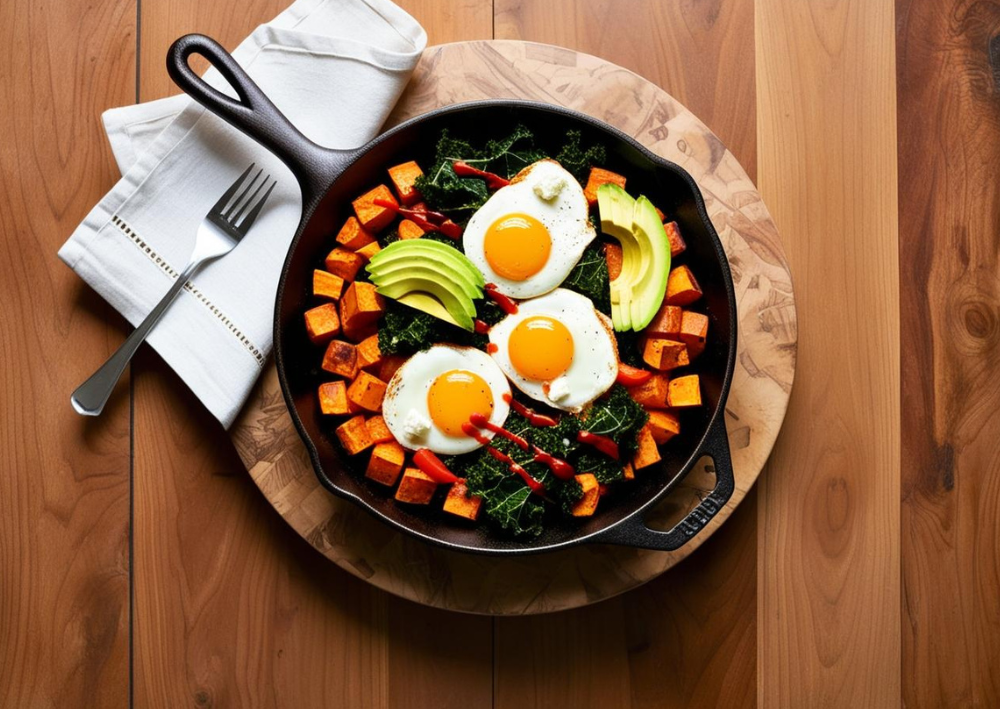
Sweet Potato and Kale Breakfast Hash
Ingredients
Equipment
Method
- Prepare the Sweet PotatoesHeat a large skillet over medium heat and add the olive oil.Once the oil is hot, add the diced sweet potatoes. Cook for about 10 minutes, stirring occasionally, until the sweet potatoes are slightly tender and golden.
- Sauté the VegetablesPush the sweet potatoes to one side of the skillet and add the onion and bell pepper. Sauté for 3-4 minutes until softened.
- Add the Kale and SpicesStir in the kale, smoked paprika, garlic powder, onion powder, salt, and pepper. Cook for an additional 5 minutes, or until the kale is wilted and tender.
- Cook the Eggs (Optional)In a separate skillet, fry or poach the eggs to your preferred doneness. Alternatively, crack the eggs directly into the hash and cover the skillet to allow them to cook for 3-4 minutes.
- Assemble and ServePlate the hash and top it with your favorite optional toppings like eggs, cheese, avocado, or hot sauce. Serve immediately and enjoy!
Notes
Make-Ahead
This Sweet Potato and Kale Breakfast Hash is a great option for meal prep! You can prepare the base of the hash (sweet potatoes, kale, bell peppers, and onions) in advance. Here’s how to make it ahead of time:- Cook the Vegetables: Roast or sauté the sweet potatoes and vegetables (kale, onions, bell peppers) until they’re cooked through and tender, but don’t add the eggs just yet.
- Cool and Store: Let the cooked vegetables cool down to room temperature, then store them in an airtight container in the refrigerator for up to 3 days. When you’re ready to serve, reheat the vegetable mixture in a skillet, and cook fresh eggs on top or mix in any proteins you’d like.
- Eggs: For the best texture, it’s recommended to cook the eggs fresh. However, if you prefer, you can also cook the eggs ahead of time and store them separately in the fridge.
Storage
If you have leftovers or prefer to make a large batch for the week, follow these storage tips:- Refrigeration: Store leftover Sweet Potato and Kale Breakfast Hash in an airtight container in the fridge for up to 4 days. Be sure to store the eggs separately if possible, as they may lose their texture when reheated.
- Freezing: While the hash can be frozen, it’s best to freeze the vegetable mixture without the eggs. You can freeze the cooked vegetables for up to 1 month. To reheat, simply thaw in the fridge overnight and reheat in a skillet. If you’re adding eggs, cook them fresh when you’re ready to serve.
- Reheating: To reheat, simply warm the hash in a skillet over medium heat until heated through. You can also microwave it, but for the best texture, the skillet method is recommended.

Nourishing Your Body and Soul with Sweet Potato and Kale
As we’ve explored, the combination of sweet potatoes and kale in this breakfast hash isn’t just a tasty way to start your day—it’s a celebration of centuries of history, nutrition, and culture. From their ancient origins to their place in modern kitchens, these two superfoods have stood the test of time, offering a wealth of health benefits and versatility. Whether you’re seeking a nutrient-packed breakfast, a hearty meal, or a simple way to nourish your body, this dish provides everything you need to feel satisfied and energized.
But beyond the nutritional benefits, there’s something truly comforting about cooking and enjoying a meal that has such rich roots. It’s about more than just the ingredients—it’s about the act of taking time for yourself, making something wholesome with your own hands, and enjoying the simple joys of good food. When you sit down to a plate of Sweet Potato and Kale Breakfast Hash, you’re not just fueling your body, you’re taking part in a long tradition of health and wellness, one bite at a time.
So, the next time you prepare this dish, take a moment to appreciate the journey these ingredients have taken through history and cultures around the world. And most importantly, savor every bite, knowing you’re feeding both your body and soul.
Join Now!
Love this recipe? Don’t miss out on even more delicious, healthy, and easy-to-make recipes like this Sweet Potato and Kale Breakfast Hash! By joining our email community, you’ll gain access to exclusive content, bonus recipes, and tips to make clean eating a breeze.
Enter your email & click below to subscribe and start receiving tasty inspiration right away. It only takes a minute to join our growing community of food lovers dedicated to making healthy eating delicious and fun.
